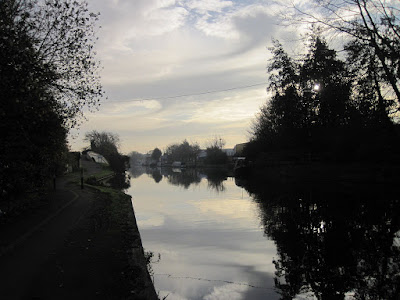Cranford to Harefield
15.50 Miles
Another frosty, bright morning greeted us as we set out: another Monday morning when we were walking whilst most were heading for school or work.
 |
| River Crane, Berkeley Meadows |
We crossed Bath Road and Cranford Bridge, and dropped down into Berkeley Meadows beside the river once again. After following the river for a while, the path struck off across Cranford Park - an open grassy area - towards St Dunstan's Church.
 |
| You 'avin' a larff? This ha ha separated the Earl of Berkeley's mansion house from the 1000 acres of parkland that surrounded it |
 |
| Stable buildings of Cranford Park House and St Dunstan's Church |
Soon we passed easily under the M4 via the underpass linking the nearby houses to the church. Looking at the traffic above, we were probably making quicker progress than they were. After another grassy area and a bit or road walking, we dropped down to meet the Grand Union Canal.
 |
| Grand Union Canal links Brentford and Birmingham |
 |
| Strange to think: 90 miles northwards beside the canal and we'd nearly be home! |
What followed next was a mile-and-a-half or so beside the canal. At the Old Crown pub, we passed the end of the Section 10 of the LOOP, and carried on into Section 11.
 |
| Grand Union Canal near Stockley Park |
We turned off the canal towpath at Stockley Park, passed through a Science Park and between two golf courses, crossed Stockley Road and climbed to a small hillock with great views and benches to sit and rest and drink and eat.
Moving on, we descended to an industrial area, A couple of turns later, we rejoined the Grand Union Canal to follow the towpath.
 |
| All the bridges on the Grand Union are numbered from the Birmingham end. This is 191st from the beginning, and there is approx one bridge every two-thirds of a mile |
After a distance beside the Grand Union, we left the main canal and struck off along a side branch known as the Slough Arm. Just beyond the Packet Boat Marina, the canal crosses the River Fray by aqueduct.
 |
| Aqueduct: canal to the right, River Fray to the left |
Leaving the canal behind, we followed a gravel path into the Colne Valley Regional Park, passed a lake, crossed a bridge over the River Colne and ended up in Buckinghamshire. There was a peculiar feeling in realising that although our home seems quite far away, it is only at the far end of the neighbouring county.
We followed the course of the river. With river beside us, small lakes nearby and sunshine overhead, this was one of the most attractive sections of the LOOP so far. We stopped to sit on some logs for lunch.
 |
| River Colne near Cowley where we ate our lunch |
We rejoined the road soon after, and 5 minutes later picked up the Grand Union again, following the towpath until it reached Oxford Road and the end of Section 11. There are many houseboats along these sections of canal, and it is interesting to see the difference between the boats - many are lived in, but while some are beautifully decorated and cared for, others are scruffy and strewn with rubbish and look uncared for.
Section 12 continued beside the canal, passing under the A40 Western Avenue to eventually reach Denham Deep Lock. Near here, I thought I spotted a Kingfisher, but the sighting was very brief and I couldn't be 100% sure.
 |
| Lake, Denham Quarry |
Beyond, the canal and river run close together, and a series of lakes formed from former gravel pits sit either side. We wove between the waterways for a while, until finally meeting the Grand Union again at Widewater Lock. The final stretch of walking for this weekend was a simple canal-side walk to the end of Section 12 by the Coy Carp pub.
 |
| Heron beside the Grand Union |
We caught a bus back to Uxbridge, where we browsed the shops briefly and went for pizza - a great way to end the long weekend. Again, we'd had a good three days - not classically beautiful walking, perhaps, but always with some interest close by, with wildlife, industrial heritage and scenes from modern life all intermingled with country parks, residential estates, golf courses, woods, rivers, lakes and common spaces. The key is to take the best from what you are seeing around you, because it's never dull!
I'll be planning our next stages soon: one thing is for sure, we are looking forward to it!












































